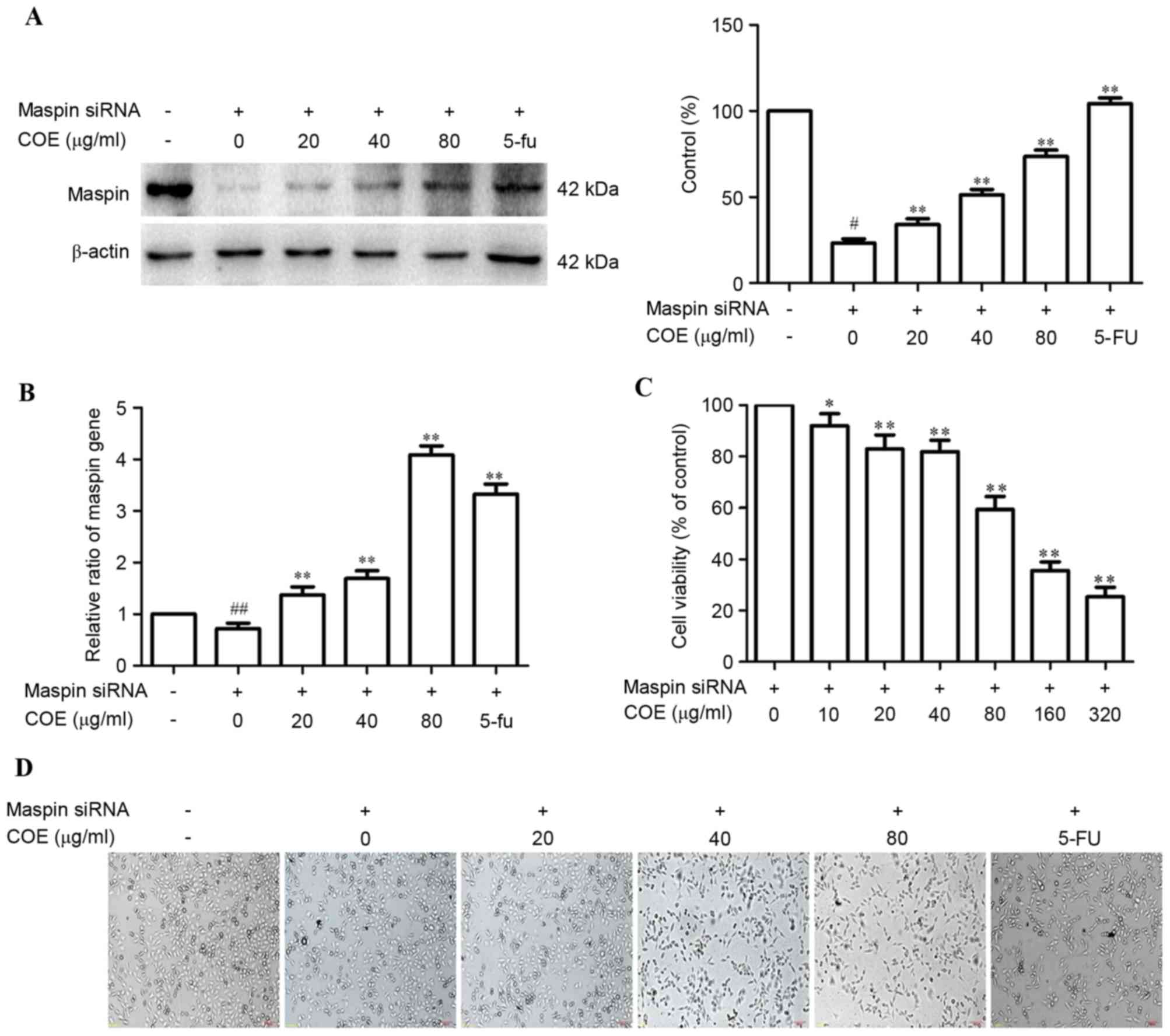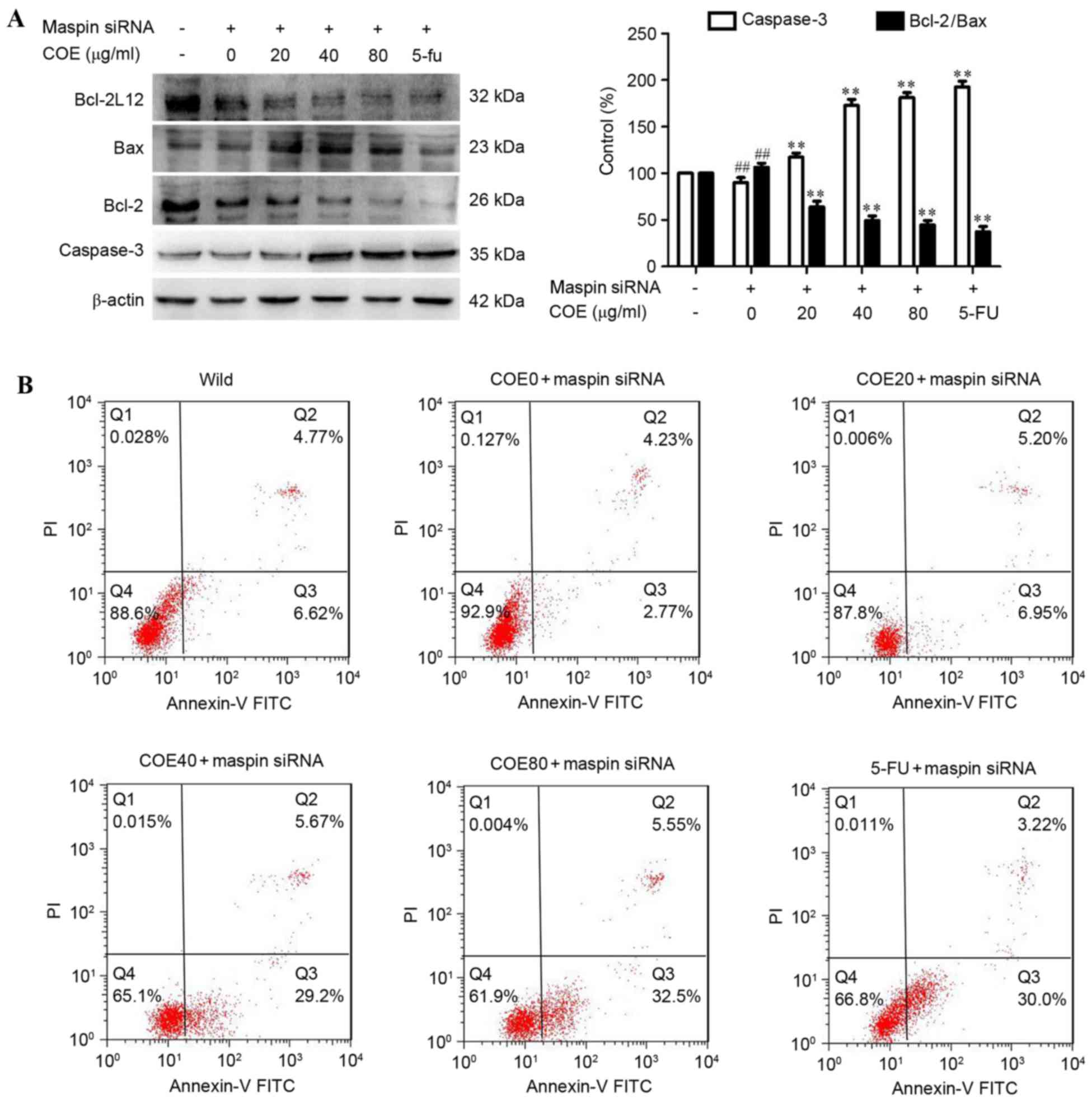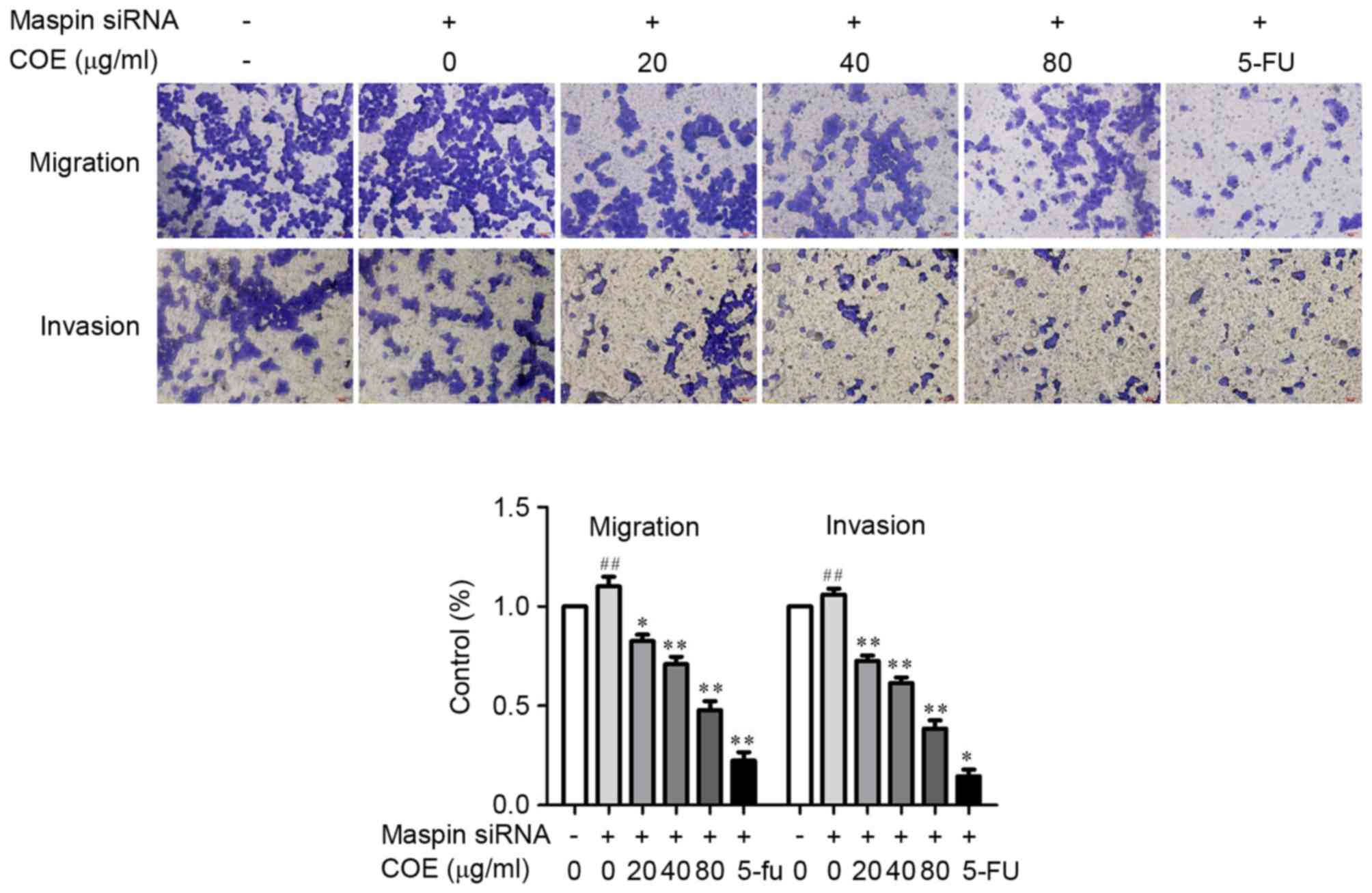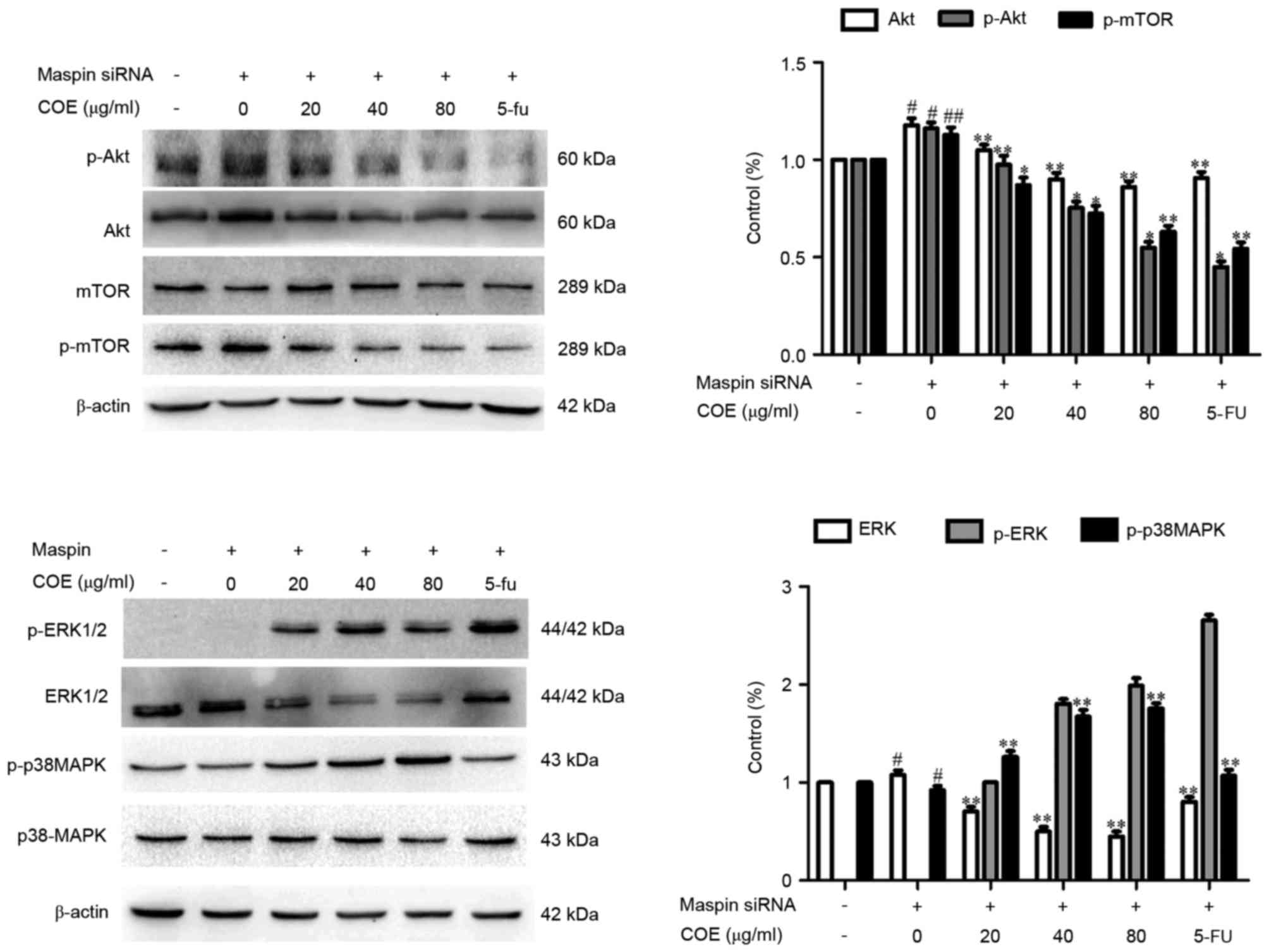Celastrus orbiculatus extracts induce apoptosis and inhibit invasion by targeting the maspin gene in human gastric adenocarcinoma cells
Retraction in: /10.3892/ol.2023.13919
- Authors:
- Published online on: November 3, 2017 https://doi.org/10.3892/ol.2017.7341
- Pages: 243-249
-
Copyright: © Qian et al. This is an open access article distributed under the terms of Creative Commons Attribution License.
Abstract
Introduction
Gastric cancer is one of the leading causes of cancer-associated mortality in the world (1). It is challenging to cure by treatments involving surgery, chemotherapy and radiation therapy, unless it is identified at an early stage (2). Although significant progress has been achieved in its systemic treatment, metastatic gastric cancer remains a major therapeutic challenge for oncologists (3,4). Therefore, it is necessary to identify new therapeutic agents with low toxicity and high selectivity to kill cancer cells and suppress tumor metastasis (4,5).
Serine protease inhibitors (serpins) are a family of proteins that inhibit chymotrypsin-like serine proteinases and control activated proteinases, and several are involved in the regulation of cell death (6–8). Maspin is a member of the serpin family and is present in normal mammary epithelial cells, but it is downregulated or absent in numerous tumor cell lines (9–11). Maspin is found in the extracellular matrix and at the plasma membrane and has been shown to act at the cell surface to block cell motility and inhibit invasion of breast and prostate cancer cells (6,9).
Celastrus orbiculatus Thunb., a Chinese traditional herb, has been used against inflammatory diseases for thousands of years in China. Previous studies have revealed that C. orbiculatus extract (COE) exhibits anticarcinogenic potentials, including the induction of cell apoptosis, inhibition of cell proliferation and inhibition of angiogenesis (12–14). COE was also revealed to inhibit migration and invasion of human colorectal carcinoma cells (15). The present study investigated whether COE effects maspin expression synergistically, with the aim of clarifying the mechanisms.
Materials and methods
Chemicals and reagents
MTT and dimethyl sulfoxide (DMSO) were acquired from Sigma-Aldrich (EMD Millipore, Billerica, MA, USA). Fetal bovine serum (FBS) and RPMI-1640 medium were purchased from Gibco (Thermo Fisher Scientific, Inc., Waltham, MA, USA). Matrigel was acquired from BD Biosciences (San Jose, CA, USA). Antibodies against extracellular regulated protein kinase (ERK; cat no. 4695, 1:1,000), phospho-ERK (cat no. 4370; 1:2,000), p38 (cat no. 2371; 1:1,000), phospho-p38 (cat no. 4511; 1:1,000), Akt(cat no. 4691; 1:1,000), phospho-Akt (cat no. 4058; 1:1,000), mechanistic target of rapamycin (mTOR; cat no. 2983; 1:1,000), phospho-mTOR (cat no. 5536; 1:1,000), caspase-3 (cat no. 9664; 1:1,000) and β-actin (cat no. 4970; 1:1,000) were purchased from Cell Signaling Technology, Inc. (Danvers, MA, USA). B-cell lymphoma-2 (Bcl-2; cat no. 39869; 1:1,000) and Bcl-2-like 12 (cat no. 37451; 1:10,000) were purchased from Epitomics (Burlingame, CA, USA). Antibodies against Maspin (cat no. B1910; 1:1,000), Blc-2-associated X protein (Bax; cat no. J3113, 1:1,000) and Maspin small interfering RNA (siRNA; cat no. sc-35859) were purchased from Santa Cruz Biotechnology, Inc. (Dallas, TX, USA). Sofast was purchased from Sunma Biotechnology Co., Ltd. (Xiamen, China). The enhanced chemiluminescent (ECL) substrate for detection of horseradish peroxidase (HRP) kit was acquired from GE Healthcare Life Sciences (Chalfont, UK). Other reagents were acquired from Beyotime Institute of Biotechnology (Jiangsu, China).
Cell lines
The human gastric carcinoma cell line MGC-803 was obtained from the Cell Bank of Shanghai Institutes for Biological Sciences (Shanghai, China). MGC-803 cells were cultured in RPMI-1640 containing 10% FBS and incubated at 37°C in a 5% CO2 atmosphere.
Plant material
The stems of C. orbiculatus plants (production batch no. 070510) were purchased from Guangzhou Zhixin Pharmaceutical Co., Ltd. (Guangzhou, China) in 2007. The preparation and characterization of COE was from the Department of Chinese Materia Medica Analysis, China Pharmaceutical University (Nanjing, China). The chemical constituents of COE were described previously (15). The resultant COE micropowder was diluted in DMSO to 1% and was further diluted with RPMI-1640 medium to different concentrations (10, 20, 40, 80, 160, 320 mg/ml) prior to use. The final concentration of DMSO did not exceed 0.1% in the cell medium (4).
Transfection of siRNA
Cells were transfected with siRNA and Sofast according to the manufacturer's protocol. Briefly, cells were seeded onto a 6-well plate at a density of 3×105 cells/well with antibiotics-free medium (Gaithersburg, MD, USA), 12 h prior to the transfection. Sofast (8 µl) in 92 µl serum-free RPMI-1640 medium was mixed with siRNA (10 µM) in 90 µl serum-free RPMI-1640 medium. The mixture was incubated at room temperature for 20 min to form a complex. After 20 min, the 200 µl transfection mixtures were added to each well with 1.8 ml RPMI-1640 medium containing 10% FBS at a final concentration (0.5 µM). Following 24 h transfection, cells were collected for RNA and protein isolation.
MTT assay
The MGC-803/maspin− cells were seeded onto a 96-well plate and treated with COE at various concentrations (0, 10, 20, 40, 80, 160 and 320 µg/ml) in triplicate to evaluate the effect of COE on cell viability. Following incubation with the drug for 24 h, MGC-803/maspin− cells were re-supplemented with 200 µl culture medium containing 10% MTT dye, and incubated for 4 h (37°C, 5% CO2). Cells were then suspended in 100 µl DMSO. The relative cell viability was determined by a microplate reader (Implen GmbH, München, Germany) at an absorbance of 490 nm.
Flow cytometry
Apoptotic cells were detected by the Annexin V-fluorescein isothiocyanate (FITC)/propidium iodide (PI) apoptosis detection kit (MACS Technology; Miltenyi Biotec GmbH, Bergisch Gladbach, Germany). Cells were digested with trypsin EDTA-free following treatment with different concentrations (0, 20, 40 and 80 µg/ml) of COE for 24 h. Following centrifugation (300 × g) at 4°C for 5 min, 1×106 cells were collected and washed twice with cold PBS. Cells were resuspended in 500 µl 1X binding buffer and then incubated for 15 min at room temperature in the dark following 5 µl Annexin V-FITC and 5 µl PI additions. For each analysis, 10,000 events were recorded.
Cell invasion and migration assays
A Transwell membrane (Costar; Corning Incorporated, Corning, NY, USA) was used for cell invasion and migration assays, according to the manufacturer's protocol. Following treatment with various concentrations of negative group (wild-type MGC-803 cells), COE group (20, 40 and 80 µg/ml) and 5-fluorouracil (5-FU) positive group (32 µg/ml) for 24 h, cells were seeded in the upper part of a Matrigel-coated invasion chamber in a serum-free medium. Medium containing 20% FBS was applied to the lower chamber. After 24 h, the cells remaining in Matrigel were removed by scraping, while the cells that invaded through Matrigel were fixed and stained by using 0.5% crystal violet (Beyotime Institute of Biotechnology) in methanol for 30 min. Images were captured under a fluorescence microscope at magnification, ×400 (Nikon Corporation, Tokyo, Japan) and invading cells were quantified by manually counting 5 fields of view. Migration assays followed in the same procedure, but with no Matrigel coating on the polycarbonate membrane. Each experiment was repeated three times.
Reverse transcription-quantitative polymerase chain reaction (RT-qPCR)
To quantitatively determine the mRNA expression levels of maspin in the MGC-803, RT-qPCR was used. Total RNA was isolated from MGC-803 cells using TRIzol reagent (Invitrogen; Thermo Fisher Scientific, Inc.) under RNase-free conditions. DNA was synthesized by a RT reaction kit (Takara Biotechnology Co., Ltd., Dalian, China). Subsequently, RT-qPCR was performed with a LightCycler 96 real-time PCR system using the SYBR Premix Ex Taq kit (Takara Biotechnology Co., Ltd.) in 96-well reaction plates (Axygen Scientific, Inc., Union City, CA, USA). All the aforementioned methods were performed by following the manufacturers' protocols. Primers were purchased from Takara Biotechnology Co., Ltd. and their primer sequences were as follows: Maspin forward, 5′-CATCCTACTACCCAAGGATGTGGAG-3′ and reverse, 5′-TTGGCATTGGCCATGGTG-3′; β-actin forward, 5′-GTGGGCCGCTCTAGGCACCAA-3′ and reverse, 5′-CTCTTTGATGTCACGCACGATTTC-3′. Data were analyzed using the comparative Cq method (2−∆∆Cq) (16).
Western blot analysis
Expression of Bcl-2, Bax, caspase-3, MAPK (p38, p-p38, ERK and p-ERK) and phosphoinositide 3-kinase (PI3K)/Akt/mTOR signaling protein (Akt, p-Akt, mTOR and p-mTOR) levels in MGC-803/maspin− cells was examined by western blot analysis. Cells were centrifuged (8000 × g, 15 min, 4°C), washed with cold PBS and lysed on ice for 30 min in lysates (Beyotime Institute of Biotechnology) containing 100 µg/ml phenylmethanesulfonyl fluoride. Protein concentrations were determined by NanoPhotometer pearl (P-330-31; Implen GmbH). Total protein (20–70 µg) was electrophoresed on 8–12% SDS-PAGE and then transferred to a nitrocellulose membrane. Following incubation with 5% non-fat dried milk for 2 h at room temperature, Primary antibodies were diluted with 5% skimmed milk powder solution and incubated with the membranes overnight at 4°C, then washed three times with Tris-buffered saline (pH 6.8) with Tween-20 (0.1%) (TBST), incubated with the secondary antibody (sheep anti-rabbit IgG-HRP; cat no. HA1001; 1:2,000; Hangzhou HuaAn Biotechnology Co., Ltd. Hangzhou, China) at room temperature for 2 h and washed three times with TBST. The ECL reagent was used to visualize the positive bands on the membrane.
Statistical analysis
All experiments were performed at least 3 times. The experimental results are presented as the mean ± standard deviation. Statistical analysis was performed by the unpaired Student's t-test using GraphPad Prism 5.0 statistical analysis software (GraphPad Software, Inc., La Jolla, CA, USA). P<0.05 was considered to indicate a statistically significant difference.
Results
Effects of COE on maspin in MGC-803 cells
To investigate the effect of COE on maspin in MGC-803 cells, maspin siRNA was transiently transfected into MGC-803 cells using Sofast kit. At 24 h post-transfection, expression of maspin mRNA and protein was assessed by RT-qPCR and western blotting, respectively. As shown in Fig. 1A, compared with wild-type MGC-803 cells, maspin protein was knocked down in the MGC-803/maspin− cells. Following treatment with COE, maspin protein was increased in a dose-dependent manner in MGC-803/maspin− cells. Maspin mRNA assay by RT-qPCR had the same results, as shown in Fig. 1B. The MTT assay showed that COE inhibited MGC-803/maspin− cell growth (Fig. 1C). The cell viability had no significant affect when the concentration of COE was <80 µg/ml. Therefore, concentrations <80 µg/ml of COE were chosen for further experiments. Phase-contrast images of cells from the same fields were captured at 24 h after transfection. Representative images of MGC-803/maspin− cells revealed that viability was decreased following treatment with COE.
COE induces apoptosis in MGC-803/maspin− cells
The effect of COE on apoptosis in MGC-803/maspin− cells was then investigated by western blot analysis and flow cytometry. As shown in Fig. 2A, following treatment with COE, expression of caspase-3 was increased, but the expression of Bcl-2/Bax was significantly reduced in a dose-dependent manner in MGC-803/maspin− cells. It was revealed that COE induced apoptosis in MGC-803/maspin− cells in a dose-dependent manner. The MGC-803 cells were labeled with PI and Annexin V. Cells in early apoptosis were Alexa PI-negative and Fluor 488-Annexin V-positive, and cells in late apoptosis were PI and Alexa Fluor 488-Annexin V-positive. The number of apoptotic cells (early and late apoptosis) reduced to 7.0% in MGC-803/maspin− cells, and the number of apoptotic cells was 11.39% in wild-type MGC-803 cells. COE promoted the apoptosis of MGC-803/maspin− cells in a dose-dependent manner (Fig. 2B).
COE inhibits invasion and migration through PI3K/Akt/mTOR and MAPK signaling pathways in MGC-803/maspin− cells
The effect of COE on invasion and migration in MGC-803/maspin− cells was investigated by Transwell assay and western blotting. Following the treatment with COE, the Transwell chamber was observed under the fluorescence microscope at magnification, ×400 (Nikon Corporation, Tokyo, Japan) and invading cells were quantified by manually counting 5 fields of view. The number of cells that invaded to the lower chamber was significantly reduced in a dose-dependent manner (Fig. 3). These results revealed that COE decreased the invasion and migration of MGC-803/maspin− cells in a dose-dependent manner, suggesting COE has an inhibitory effect on the metastatic process of MGC-803/maspin− cells. As shown in Fig. 4, the phosphorylation of Akt, p-mTOR and ERK was significantly inhibited (P<0.01) by COE compared with the control group. By contrast, the total protein levels of p38 and mTOR were not markedly changed following COE treatment. The total protein level of p-p38 was increased in the MGC-803/maspin− cells dose-dependently. In conclusion, these data revealed that COE inhibits the invasion and migration of MGC-803/maspin− cells, possibly through the PI3K/Akt/mTOR and MAPK signaling pathways.
Discussion
Traditional Chinese Medicine (TCM) is widely used as a therapy in patients with cancer worldwide, to suppress tumor proliferation, induce apoptosis and prevent complications (17). TCM also serves an important role in reducing the side effects and improving the quality of life of conventional treatments in patients with cancer (17–20). In previous years, bioactive component extracts from TCM were identified as therapeutic agents, and were effective in the prevention of potential cancers (4,13,21). An ethyl acetate extract of C. orbiculatus was revealed to have a significant ability against various human tumor cell lines to inhibit proliferation and induce apoptosis (20,22–24).
Suppressor gene maspin expression is reduced or absent in numerous tumor cells (6). Increasing the level of maspin expression in tumor cells may promote tumor cell apoptosis and inhibit invasion and metastasis, inhibit tumor angiogenesis and even increase the sensitivity of tumor cells to chemotherapy (6–10). Apoptosis is a defensive mechanism of the body to eliminate malignant cells, and it has a significant role in preventing cancer. Notably, the predominant function of numerous antitumor drugs is to induce apoptosis in tumor cells via various apoptosis-associated signaling pathways (25). In the present study, western blot analysis demonstrated that COE can reduce the expression of Bcl-2 protein, and increase the expression of Bax and caspase-3 total protein, decreasing Bcl-2/Bax. COE performs a pro-apoptotic role through Bcl-2, Bax and caspase-3-mediated signaling pathways.
There may be other factors that may affect the invasion and metastasis of tumor cells, but each process requires migration ability. The Transwell assay is a common method of detecting migration of tumor cells in vitro; the number of cells in the small compartment at the bottom of the polycarbonate film reflects cell migration. The present results reveal that compared with wild-type MGC803 cells, the number of cells that migrated through the Transwell chamber increased significantly in MGC803 cells with low expression of the tumor suppressor gene maspin. With increasing COE concentration, the ability to inhibit gastric cancer cell migration was more evident. COE may enhance the effect of the tumor suppressor gene maspin to inhibit tumor cell migration.
The invasion and metastasis of tumor cells is coordinately regulated by a variety of cytokines and signaling pathways. ERK1/2, MAPK and PI3K/Akt/mTOR signaling pathways are major signal transduction pathways in the regulation of tumor invasion and metastasis (26,27). Therefore, the effect of the tumor suppressor gene maspin and COE on the key protein molecular expression and phosphorylation levels of the MAPK and PI3K/Akt/mTOR signaling pathways was analyzed. It was identified that COE significantly inhibited the phosphorylation of Akt and ERK, while promoting the expression of p-P38MAPK. Therefore, COE targeting of maspin to inhibit metastasis of gastric cancer cells may occur through MAPK and PI3K/Akt/mTOR signaling pathways. The present study also demonstrated that TCM inhibiting tumor invasion and metastasis may be a multi-target, multi-channel integrated action. The antitumor mechanisms should be assessed from cells, molecules and systematic study of animal models.
In the present study, the results demonstrated that COE increased the expression level of maspin to inhibit the proliferation of gastric cancer cells and induce apoptosis in a concentration-dependent manner. Furthermore, COE targeting maspin to inhibit the migration and invasion of MGC803 cells may be through MAPK and PI3K/Akt/mTOR signaling pathways. In terms of the underlying mechanisms, the results of the present study demonstrated that COE affects maspin expression synergistically to induce apoptosis and inhibit invasion and migration in gastric cancer cells by regulating apoptosis-associated proteins and inhibiting MAPK and PI3K/Akt/mTOR signaling pathways.
In conclusion, COE may be a potential therapy against gastric cancer. Nevertheless, all experiments were performed in vitro, and in vivo studies are required for additional investigation. The present findings reveal that COE has a promising prospect in treating metastatic gastric cancer.
Acknowledgements
The present study was supported by the National Natural Science Foundation of China (grant nos. 81403232 and 81274141), the National Natural Science Foundation of Jiangsu Province (grant nos. BK2012686 and BK 20171290) and the Doctoral Fund of the Ministry of Education of China (grant no. 20133250120003).
References
|
Wu HH, Lin W and Tsai KW: Advances in molecular biomarkers for gastric cancer: miRNAs as emerging novel cancer markers. Expert Rev Mol Med. 16:e12014. View Article : Google Scholar : PubMed/NCBI | |
|
Kim SJ, Wang YG, Lee HW, Kang HG, La SH, Choi IJ, Irimura T, Ro JY, Bresalier RS and Chun KH: Up-regulation of neogenin-1 increases cell proliferation and motility in gastric cancer. Oncotarget. 5:3386–3398. 2014. View Article : Google Scholar : PubMed/NCBI | |
|
Kanat O and O'Neil BH: Metastatic gastric cancer treatment: A little slow but worthy progress. Med Oncol. 30:4642013. View Article : Google Scholar : PubMed/NCBI | |
|
Zhu YD, Liu YQ, Qian YY, Zhang H, Li GQ and Yang L: Extracts of Celastrus orbiculatus exhibit anti-proliferative and anti-invasive effects on human gastricadenocarcinoma cells. Chin J Integr Med. Nov 10–2014.(Epub ahead of print). View Article : Google Scholar | |
|
Wang S, Zhong Z, Wan J, Tan W, Wu G, Chen M and Wang Y: Oridonin induces apoptosis, inhibits migration and invasion on highly-metastatic human breast cancer cells. Am J Chin Med. 41:177–196. 2013. View Article : Google Scholar : PubMed/NCBI | |
|
Tarakji B, Ashok N, Sheirawan MK, Altamimi MA, Alenzi F, Azzeghaiby SN, Baroudi K and Nassani MZ: Maspin as a tumour suppressor in salivary gland tumour. J Clin Diagn Res. 8:ZE05–ZE07. 2014.PubMed/NCBI | |
|
Bodenstine TM, Seftor RE, Seftor EA, Khalkhali-Ellis Z, Samii NA, Monarrez JC, Chandler GS, Pemberton PA and Hendrix MJ: Internalization by multiple endocytic pathways and lysosomal processing impact maspin-based therapeutics. Mol Cancer Res. 12:1480–1491. 2014. View Article : Google Scholar : PubMed/NCBI | |
|
Lovato A, Lionello M, Staffieri A, Blandamura S, Tealdo G, Giacomelli L, Staffieri C and Marioni G: A higher angiogenin expression is associated with a nonnuclear maspin location in laryngeal carcinoma. Clin Exp Otorhinolaryngol. 8:268–274. 2015. View Article : Google Scholar : PubMed/NCBI | |
|
Bagheri M, Eghtedari M, Bagheri M, Geramizadeh B and Talebnejad M: Expression of Maspin and Ezrin proteins in periocular basal cell carcinoma. Dermatol Res Pract. 2014:5965642014.PubMed/NCBI | |
|
Dzinic SH, Chen K, Thakur A, Kaplun A, Bonfil RD, Li X, Liu J, Bernardo MM, Saliganan A, Back JB, et al: Maspin expression in prostate tumor elicits host anti-tumor immunity. Oncotarget. 5:11225–11236. 2014. View Article : Google Scholar : PubMed/NCBI | |
|
Lonardo F, Guan H, Dzinic S and Sheng S: Maspin expression patterns differ in the invasive versus lepidic growth pattern of pulmonary adenocarcinoma. Histopathology. 65:757–763. 2014. View Article : Google Scholar : PubMed/NCBI | |
|
Wang WM, Liu YQ and Dai XJ: Apoptosis of Hela cell induced by Celastrus orbiculatus Thunb extract and primary mechanisms. Chin-German J Clin Oncol. 10:666–668. 2011. View Article : Google Scholar | |
|
Qian YY, Zhang H, Hou Y, Yuan L, Li GQ, Guo SY, Hisamits T and Liu YQ: Celastrus orbiculatus extract inhibits tumor angiogenesis by targeting vascular endothelial growth factor signaling pathway and shows potent antitumor activity in hepatocarcinomas in vitro and in vivo. Chin J Integr Med. 18:752–760. 2012. View Article : Google Scholar : PubMed/NCBI | |
|
Ma H, Qian YY, Zhang H, Xue JI, Yaodong ZHU, Pingfang CUI and Yanqing LIU: Celastrus orbiculatus extract could inhibit human colorectal carcinoma HT-29 cells metastasis via suppression of the mTOR signaling pathway. Life Sci J. 10:1704–1710. 2013. | |
|
Zhang H, Qian Y, Liu Y, Li G, Cui P, Zhu Y, Ma H, Ji X, Guo S and Tadashi H: Celastrus orbiculatus extract induces mitochondrial-mediated apoptosis in human hepatocellular carcinoma cells. J Tradit Chin Med. 32:621–626. 2012. View Article : Google Scholar : PubMed/NCBI | |
|
Livak KJ and Schmittgen TD: Analysis of relative gene expression data using real-time quantitative PCR and the 2(-Delta Delta C(T)) method. Methods. 25:402–408. 2001. View Article : Google Scholar : PubMed/NCBI | |
|
Hong M, Wang N, Tan HY, Tsao SW and Feng Y: MicroRNAs and Chinese medicinal herbs: New possibilities in cancer therapy. Cancers (Basel). 7:1643–1657. 2015. View Article : Google Scholar : PubMed/NCBI | |
|
Su CX, Wang LQ, Grant SJ and Liu JP: Chinese herbal medicine for cancer-related fatigue: A systematic review of randomized clinical trials. Complement Ther Med. 22:567–579. 2014. View Article : Google Scholar : PubMed/NCBI | |
|
Chen CM, Lin LZ and Zhang EX: Standardized treatment of Chinese medicine decoction for cancer pain patients with opioid-induced constipation: A multi-center prospective randomized controlled study. Chin J Integr Med. 20:496–502. 2014. View Article : Google Scholar : PubMed/NCBI | |
|
Luo FR, Ding J, Chen HX, Liu H, Fung MC, Koehler M, Armand JP, Jiang L, Xu X, Zhang G, et al: Breakthrough cancer medicine and its impact on novel drug development in China: Report of the US Chinese anti-cancer association (USCACA) and Chinese society of clinical oncology (Csco) joint session at the 17th CSCO annual meeting. Chin J Cancer. 33:620–624. 2014.PubMed/NCBI | |
|
Zhu Y, Liu Y, Qian Y, Dai X, Yang L, Chen J, Guo S and Hisamitsu T: Antimetastatic effects of Celastrus orbiculatus on humangastric adenocarcinoma by inhibiting epithelial-mesenchymal transition and NF-κB/snail signaling pathway. Integr Cancer Ther. 14:271–281. 2015. View Article : Google Scholar : PubMed/NCBI | |
|
Zhu Y, Liu Y, Qian Y, Dai X, Yang L, Chen J, Guo S and Hisamitsu T: Research on the efficacy of Celastrus Orbiculatus in suppressing TGF-β1-induced epithelial-mesenchymal transition by inhibiting HSP27 and TNF-α-induced NF-κB/Snail signaling pathway in human gastric adenocarcinoma. BMC Complement Altern Med. 14:4332014. View Article : Google Scholar : PubMed/NCBI | |
|
Wang M, Zhang X, Xiong X, Yang Z, Sun Y, Yang Z, Hoffman RM and Liu Y: Efficacy of the Chinese traditional medicinal herb Celastrus orbiculatus Thunb on human hepatocellular carcinoma in an orthothopic fluorescent nude mouse model. Anticancer Res. 32:1213–1220. 2012.PubMed/NCBI | |
|
Jeon H: Anti-metastatic effects of celastrus orbiculatus extract in B16F10 melanoma cells. Nat Prod Sci. 17:135–141. 2011. | |
|
Jin X and Shi YI: Isobavachalcone induces the apoptosis of gastric cancer cells via inhibition of the Akt and Erk pathways. Exp Ther Med. 11:403–408. 2016. View Article : Google Scholar : PubMed/NCBI | |
|
Nguyen KC, Willmore WG and Tayabali AF: Cadmium tellunde quantum dots cause oxidative stress leading to extnnsic and intrinsic apoptosis in hepatocellular carcinoma HepG2 cells. Toxicology. 306:114–123. 2013. View Article : Google Scholar : PubMed/NCBI | |
|
Wu R, Duan L, Ye L, Wang H, Yang X, Zhang Y, Chen X, Zhang Y, Weng Y, Luo J, et al: S100A9 promotes the proliferation and invasion of HepG2 hepatocellular carcinoma cells via the activation of the MAPK signaling pathway. Int J Oncol. 42:1001–1010. 2013. View Article : Google Scholar : PubMed/NCBI |













